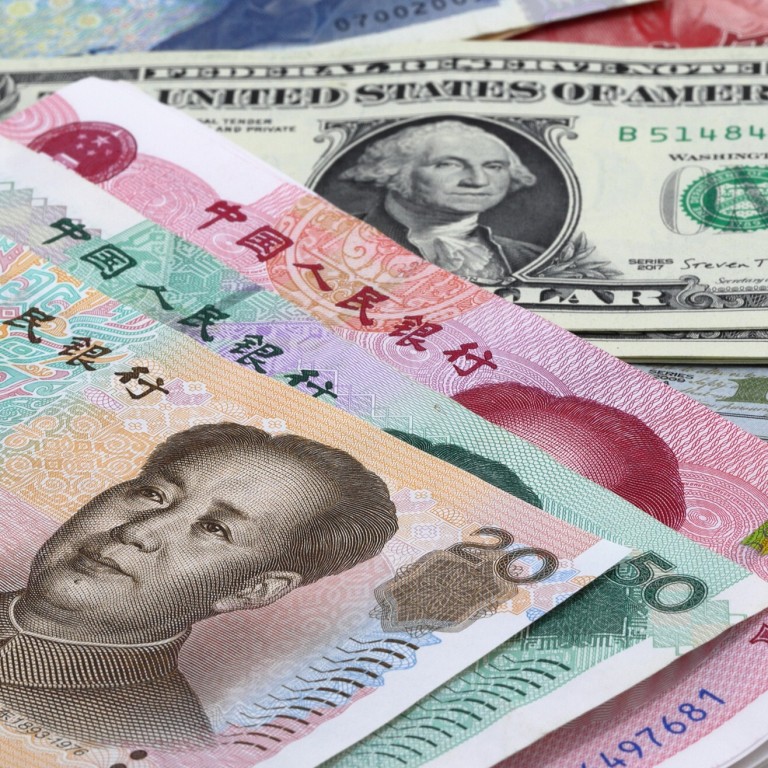
Will the US dollar’s slide erode its status as the world’s currency of choice?
- In October, the US dollar lost its crown as the world’s most used global payments currency, slipping behind the euro for the first time since August 2013
- Its share in global currency reserves is still dominant, but geopolitics and near-zero US interest rates have countries and investors looking for alternatives
The US dollar’s sharp decline this year has raised questions about it losing its status as the pre-eminent reserve currency and dominant force in the global payments.
The US dollar has weakened by 13 per cent against a basket of major currencies since its peak in March, fuelled by worries about expansionary US fiscal and monetary policies and a ballooning current account deficit in response to the Covid-19 pandemic.
While an imminent collapse is very unlikely, there is risk of a prolonged downward adjustment in the perception of the US currency, analysts said.
Underlying geopolitical risks and changing international dynamics could, over time, undermine the US dollar’s leading position in today’s foreign exchange trading, cross-border trade transactions and international debt markets, they warned.
There are certainly other liquid currencies out there that will increasingly be used for payments
“Undoubtedly there has been a reduction of the strength of the US dollar that is something that we expect to continue,” said Kevin Anderson, head of investments in the Asia-Pacific region for State Street Global Advisors. “There are certainly other liquid currencies out there that will increasingly be used for payments.”
The amount of money flowing into the US will slow because the US Federal Reserve has signalled it will keep interest rates anchored near zero through 2023, diminishing the attractiveness of US debt markets and investments, Anderson said.
And after years of subpar growth in the euro zone, investors are now diversifying allocations into euro-denominated assets.

05:02
Coronavirus backlash further fraying China’s ties to global economy
Similarly, the issuance of euro-denominated bonds has been expanding, making up a third of hard currency sovereign debt issued globally in recent years in part because of funding currency diversification by emerging market governments, including Mexico, Chile, Indonesia, Egypt and Morocco, said Regis Chatellier, director of emerging market strategy at Oxford Economics.
Nevertheless, history suggests the US dollar will maintain its status as the leading global reserve currency for at least another two decades, according to Andrew Fennell, senior director, sovereign ratings at Fitch Ratings.
The US surpassed Britain as the world’s largest economy in 1872 and as a leading exporter during World War I, before the US dollar began to challenge the pound sterling as the world’s leading reserve currency in the mid-1920s.
But geopolitics is an area of uncertainty that could erode the dominance of the US currency.
Washington’s willingness to impose financial sanctions on foreign entities and individuals has raised concern in some countries about the safety of US dollar-denominated assets in their reserve portfolios and held with international institutions.
“Amid heightened geopolitical tensions between China and a number of major economies including the US, governments around the world may be forced to make strategic decisions about where to allocate their foreign reserves based on both financial and security considerations,” Fennell said.
The US dollar’s share in global currency reserves is still by far the most dominant, but it has been slipping, falling by about 10 percentage points over the past two decades to 62 per cent today, according to the International Monetary Fund (IMF).
The currency’s use as an exchange rate peg has also declined over the past decade. Among the IMF’s 191 members, 38 use the US dollar as an anchor in their currency boards, conventional pegs or stabilised arrangements, down from 48 in 2011.
While it would be premature to say the US dollar’s role as the premier reserve currency is near an end, other currencies will continue to gain prominence.
Foreign inflows to China are forecast to range between 1.3 trillion yuan (US$199 billion) and 1.5 trillion yuan in 2021, with foreign net purchases of Chinese government bonds rising more than 40 per cent in the next year, after growing 14 per cent in 2020, according to Becky Liu, head of China macro strategy at Standard Chartered Bank.
“The structural increase in global asset allocation to China onshore bonds has just begun, and inflows are likely to accelerate due to the current attractive valuations of China bonds versus global peers,” Liu said.
The Chinese government’s 10-year bond currently yields around 3.3 per cent, while the US Treasury 10-year note yields around 0.90 per cent and the benchmark German government 10-year bond yields a negative 0.6 per cent.

